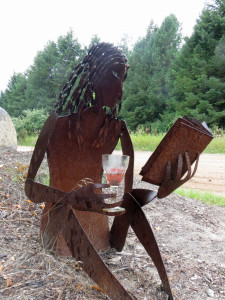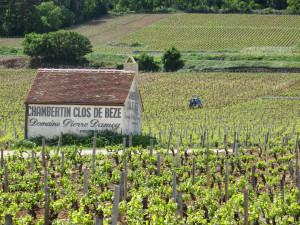Should New Hybrid Grapes Be More Old World?
Evaluating wine is no easy job.
Many art forms – like music and painting- continually develop new genres to accommodate new influences. But wine is different. Even today, wine appreciation is based on the proposition that a very limited number of grapes can produce “quality” wine.
The highly subjective nature of wine comparison creates a dilemma for Midwest winemakers. Non-European grapes can either be made into wines that don’t fit neatly into a pre-existing category, or winemakers can strive to make hybrid grapes taste like old world wines.
Midwest Wine Press spoke recently with leaders of the Midwestern wine industry about this issue. We posed the question, “Should the development of new hybrid wine grapes be focused on creating grapes that have vinifera like characteristics, or should new grapes be part of an effort to take wine in a different direction?”
Tom Plocher, a leading Northern grape breeder who developed the Petite Pearl grape, said he has made a “subtle shift” towards satisfying established preferences. “What’s acceptable to wine drinkers is the most important,” Plocher said. “We don’t want to go too far off the vinifera path with the grapes we’re developing.”
Plocher is currently part of the North Dakota State University (NDSU) grape breeding program. At NDSU, the benchmarks for new hybrid wine grape trails are vinifera grapes.
More specifically, Plocher said his current breeding work evaluates all potential hybrid parents in terms of polyphenol content and the portion of the polyphenols that are tannins. This ratio of polyphenols to tannins is one of the main distinguishing characteristics of vinifera wines, Plocher said.
Low tannic content is one of the perceived deficiencies of hybrid wines that Plocher is seeking to address. “One of our rules for creating new grapes is that we must have at least one parent with good tannin content,” he said.
The successful grape breeding program at the University of Minnesota has a track record for hybrid cultivars that can compete with established European grapes. University of Minnesota hybrids like Marquette and La Crescent have attracted international interest because they have characteristics normally associated old world wines.
U of M enology project leader Katie Cook, who has worked and lived in Europe and Australia, believes cultural and historical factors weigh heavily in consumer taste preferences. The “one wine style fits all” school of thought is over simplistic in Cook’s opinion.
“LaCrescent and Marquette are examples of how our program is moving in a traditional direction,” Cook said. “However, that (tradition) shouldn’t be the only goal when you consider the success of Labrusca grapes in the Midwest.”
Cook says that some of the terroir and “localness” of Midwest winemaking leans toward labrusca style wines. “People in the U.S. grew up drinking Welch’s grape juice and eating fruity grape jelly, so they are comfortable and familiar with those flavors,” Cook says.
Jennifer Johnson, a certified sommelier and marketing director at Chaumette Vineyards and Winery in Missouri, agrees with Cook that consumer tastes are continually evolving. “Perhaps Cabernet Sauvignon did not taste that great 500 or 600 year ago,” she said, “but we’re not that patient now.”
Chaumette’s Johnson does not like how all hybrid and native grapes have been lumped together into a single category. She feels that certain grapes that grow well in the Midwest deserve more respect.
“Take Catawba as an example,” Johnson said. “If it’s made properly, it’s a wonderful wine. In fact, it’s one of the best sparklings to have with dessert. Catawba is its own distinct grape and winemakers are learning to take the coarseness out of it. It’s a lot more like vinifera these days.”
Hank Johnson of Chaumette (no relation to Jennifer) thinks Chardonel is an example of a hybrid grape that can “make the grade” with serious wine drinkers.
“We think Chardonel is a really special grape,” Hank Johnson said. “We sent two Chardonels to the San Diego International Wine Competition and we won a Gold and a Silver medal. I can only imagine the look on the judges faces when they realized they were drinking a hybrid wine.”
For red wines, Norton quality has also come a long way in the past eight or nine years, Jennifer Johnson believes. “The best Norton tastes a lot more like vinfieras. That “foxy” hybrid qualtity is going away.”
The “foxy” quality Johnson alludes to is the result of the native lineage of many hybrid wine grapes. Native grapes, like Riparia “River” grapes are naturally disease resistant and cold tolerant which makes them good breeding stock for new wine grapes.
On the downside, Plocher said that Riparia based wines have two characteristics that can turn off traditional wine drinkers, the first being high acid and the other low tannins.
“Part of my job is to minimize these (native grape) weaknesses in the new hybrid grapes,” Plocher said. “For example, we’re taking the hardiest of the hardy, like the MN 1094 grape (which contains Riparia genes) and crossing them with premium vinifera grapes like Cab Sauv and Cab Franc.”
Vinifera and hybrid have become two distinct wine categories, but not everyone subscribes to this dichotomy. “Rather than focus on what’s a hybrid wine and what’s not, we prefer to focus on being in the quality wine category,” Hank Johnson said. “That might be Chardonnay today and Chardonel tomorrow.”
 Plocher said that he is now breeding grapes with wine quality as the primary goal. Cold hardiness and disease resistance are still important, but they are taking a back seat to taste and aroma.
Plocher said that he is now breeding grapes with wine quality as the primary goal. Cold hardiness and disease resistance are still important, but they are taking a back seat to taste and aroma.
Selecting for quality first and then crossing with riparia is an approach that may produce wine grapes with new characteristics that appeal to traditional wine drinkers, Plocher said.
And what are the characteristics that define quality wine? According to Hank Johnson, any fine wine has pleasing aromatics, good weight, a long, pleasant finish and multi-dimensional flavors.
Jennifer Johnson says that hybrid grapes with distinctive personalities are well suited today’s style of winemaking. “The trend is towards less filtering and fining so the natural qualities of the grape show through. The same is true with natural fermentations.”
Enthusiasm for hybrid grapes is tempered by the medieval pace of grape breeding. Until a grape is invented that can produce more than one crop a year, cross breeding will continue to be a tedious process. But new technologies are allowing plant scientists to isolate desirable grape genetics in the lab and consumer beverage trends in the United States can change very quickly.
“Maybe there is a time coming when a wine grape is just a wine grape,” Plocher says. “There’s a new generation of wine drinkers and that’s the potential market for new styles of wine.”
Editor’s note: As a comment to Piero Spada’s recent Midwest Wine Press story about Petite Pearl, Tom Plocher shared the following news about new grapes he’s developing:
Here’s when we can expect some of Tom’s newer hybrids to be released:
1) TP 1-1-34 Expect some limited availability in 2015, more realistic release in 2016. High tannin content relative to all quantified cold hardy hybrids. TP/ tannin ration of 3. Reminds Tom in style of Sangiovese.
2) TP 1-1-12 Described as Sabrevois nose meets P. Pearl Structure. As such, a Quebec nursery is the first to propagate significant numbers, expected release 2016. TP / tannin ratio of 6.0
3) TP 2-1-17 The sister of Petite Pearl. TP / tannin ratio of 6.0. Lighter color than Petite Pearl. Best used for rose and soft fruity dry reds.



